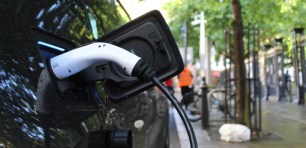
Rivian is heavily invested in a subscription-based business model. Source: supplied.
Last week, electric vehicle manufacturer Rivian went public in spectacular fashion. It launched on the New York Stock Exchange and was valued at more than US$100 billion ($1.37 billion) despite having delivered less than 200 vehicles to customers. That makes it more valuable than both Ford and General Motors.
Why such bullishness? Well, the fact it’s a 100% electric company in a world quickly leaving fossil fuels behind is vital. And so is its niche — at the moment it’s focusing on utes, SUVs and vans. But I think there’s another factor at play here: Rivian is heavily invested in a subscription-based business model.
That’s important for a number of reasons, none more than value.
Owning a car is an expensive business. On top of the vehicle itself there’s compulsory registration, insurance, fuel, maintenance and repairs. That’s all before we get to depreciation. But depreciation is more about value than upfront cost — and that’s a crucial distinction.
Few people complain about the cost of a product or service if it serves them well over a long period of time. And for some — people whose work necessitates lots of driving, for example — a car is such an essential part of daily life its value remains high as long as it stays roadworthy. For many others, though, the value equation is quite different.
According to Morgan Stanley the average car is used for less than an hour a day. It has a utilisation rate of 4%. Compare that with, say, the frequency with which you use your mobile phone or your laptop and the number is stark.
Am I comparing apples with oranges here? Well, not necessarily. Mobiles depreciate fast and, in the same way you can’t drive a car without rego and petrol, you don’t get much out of a phone without power and access to a network and data.
It’s also important to remember that cars, like modern phones, have been operating on software for decades. But can you imagine acquiring a brand new mobile and then accepting that you’ll be unable to upgrade the operating system or any of the apps you depend on each day?
Here’s where, until recently, the gap between cars and other essential staples of life in the digital era was vast. If you bought a new car in 2017 and it wasn’t a Tesla, you bought software that was never going to change. In other words, if you were an average Australian driver, you purchased a product that was going to sit in a garage or carport for 96% of the time and which would never adjust its performance to suit your needs and expectations.
That’s all about to change.
I mentioned Tesla earlier because they did things differently. They introduced over-the-air (OTA) updates all the way back in 2012. OTA is the same technology that automatically and wirelessly upgrades your phone’s operating system or patches any glitches.
And this brings us back to Rivian.
Just like a mobile phone, a Rivian vehicle comes with multiple pre-installed systems — kind of like phone apps. They can be updated and upgraded as part of your Rivian subscription. They include a hands-free driver assistance system, a driver monitoring system, battery management, thermal management, telematics and more.
This new way of thinking, pioneered by Tesla and now becoming standard (among both electric vehicle newcomers and traditional OEMs moving with the electric times) goes a long way to solving the problem of car value. Volvo only a few weeks ago revealed that an OTA update to their very first fully electric vehicle will not just improve the electronic system, but increase the car’s charging speed and its range. Any product that continues to improve over the course of its life is self-evidently more valuable than one that remains exactly the same.
The other major problem is utilisation, and subscriptions have this covered in an even more comprehensive way. When you subscribe to a vehicle through companies like Loopit and Carbar here in Australia (both Zuora customers), you don’t pay for a product that you only use for an hour or two a day; you pay per week or month, discontinuing your subscription as your needs change. You’re now not owning a thing; you’re using a service.
And as part of that service you get the software updates as I’ve explained, but you also get customisation to meet the preferences of a single owner. That’s right, a usership model focused on personalisation makes it possible for one car to have multiple users with tailored connected services and software — a different set of parameters for each subscriber. This is good for the vehicle’s users, but also good for sustainability because it extends the life of the asset.
Rivian and companies like it are showing us the future of cars. Electric, yes. Software enriched, without doubt. But also brought to drivers via a highly customisable, potentially multi-user, subscription. The car as a costly product will be replaced by mobility as a service.
Handpicked for you

Morrison’s new $500 million fund for low-emissions tech to enable investment in CCS



COMMENTS
SmartCompany is committed to hosting lively discussions. Help us keep the conversation useful, interesting and welcoming. We aim to publish comments quickly in the interest of promoting robust conversation, but we’re a small team and we deploy filters to protect against legal risk. Occasionally your comment may be held up while it is being reviewed, but we’re working as fast as we can to keep the conversation rolling.
The SmartCompany comment section is members-only content. Please subscribe to leave a comment.
The SmartCompany comment section is members-only content. Please login to leave a comment.